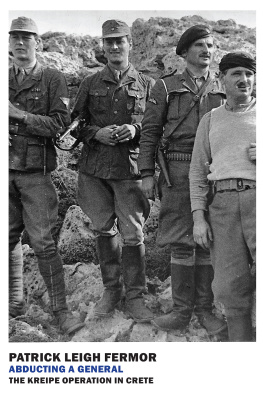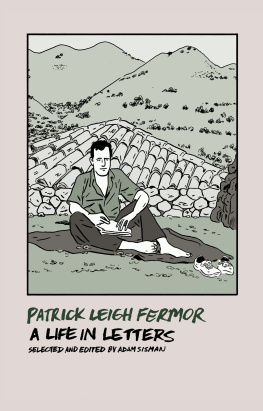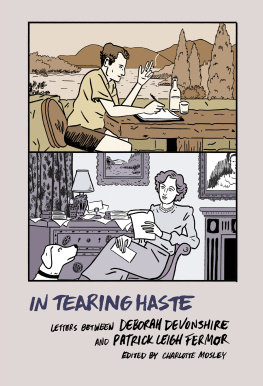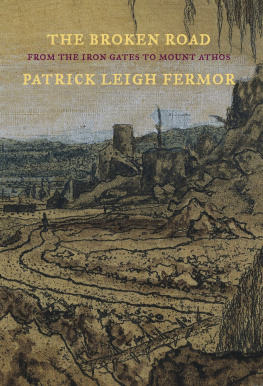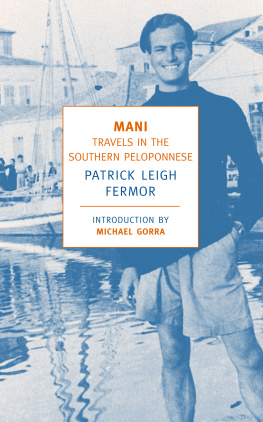PATRICK LEIGH FERMOR was born in 1915 of English and Irish descent. After his stormy schooldays, followed by the walk across Europe to Constantinople that begins in A Time of Gifts (1977) and continues through Between the Woods and the Water (1986), he lived and traveled in the Balkans and the Greek Archipelago. His books Mani (1958) and Roumeli (1966) attest to his deep interest in languages and remote places. In the Second World War he joined the Irish Guards, became a liaison officer in Albania, and fought in Greece and Crete. He was awarded the DSO and OBE. He now lives partly in Greece in the house he designed with his wife Joan in an olive grove in the Mani, and partly in Worcestershire. He was knighted in 2004 for his services to literature and to BritishGreek relations.
JAN MORRIS was born in 1926, is Anglo-Welsh, and lives in Wales. She has written some forty books, including the Pax Britannica trilogy about the British Empire, studies of Wales, Spain, Venice, Oxford, Manhattan, Sydney, Hong Kong, and Trieste, six volumes of collected travel essays, two memoirs, two capricious biographies, and a couple of novelsbut she defines her entire oeuvre as disguised autobiography. She is an honorary D. Litt. of the University of Wales and a Commander of the Order of the British Empire.
BETWEEN THE WOODS AND THE WATER
On Foot to Constantinople: The Middle Danube to the Iron Gates
PATRICK LEIGH FERMOR
Introduction by
JAN MORRIS
NEW YORK REVIEW BOOKS

New York
CONTENTS
INTRODUCTION
O N HOLY Saturday, 1934, the nineteen-year-old Patrick (Paddy) Leigh Fermor stood on a bridge over the Danube at Esztergom, some forty miles upstream from Budapest, and contemplated his situation.
He had quite recently been asked to leave Kings School, Canterbury, because of conduct unbecoming (i.e., holding hands with a tradesmans daughter in the town), although his intellect was beyond the dreams of schoolmasters. His memory was brilliant, he had marvelous gifts of observation and description, his command of languages was instinctive, and he had already developed formidable powers of historical scholarship. But he was a born individualist, an adventurer, and it was as a cheerful dropout that he had, three months before, embarked upon a solitary walk across the continent of Europe, from the Hook of Holland to Constantinople.
Now he was about halfway there, having traveled, mostly on foot, through the Netherlands, Germany, Austria, and Czechoslovakia, roughly following the courses of the Rhine and the Danube, but making detours and side excursions whenever he felt like it. He had usually traveled rough, consorting with tramps, gypsies, farmers, and anyone else he met on the road, but occasionally he had stopped off for a few days in the house of some hospitable acquaintance, if only to use the library.
From the bridge at Esztergom, at the frontier between Slovakia and Hungary, while the citizens of the town swarmed about him preparing for their Easter celebrations, he looked expectantly for the first time towards the intoxications of Middle Europeromantic bravado of the Hungarians, weird legends and traditions of Transylvania, the wild majesty of the Danube itself as it swept through gorge, marsh and forest towards the Black Sea.
* * *
Before we join him on his journey we must pause for contemplation ourselves, because it is not exactly the Paddy Leigh Fermor we see at Esztergom who is the author of this book. Five years later the young backpacker was to become Major Patrick Leigh Fermor, DSO, OBE, a war hero celebrated for parachuting into Nazi-occupied Crete, kidnapping a German general, and smuggling him away to Egypt, and in the years after that he had written three books of travel which had given him literary fame too. It was only when he was in his sixties that he set about turning his youthful walk across Europe into a book. The first volume of the consequent work, A Time of Gifts, was published in 1977 and instantly recognized as a classic. This second volume, Between the Woods and the Water, appeared in 1986, and by then Leigh Fermor was seventy-one years old.
So half a century separates the experience from the book, and the author is looking back at himself across a great gulf of experience and of history. The Second World War has changed Europe forever since Paddy hoisted his rucksack at the Hook of Holland, and his alter ego too has been weathered by a lifetime of travel and accomplishment. It really is almost as though Between the Woods and the Water is the work of two separate writers, coming to the task from opposite directions, but blending their talents in a display of intergenerational collaboration.
And it is a triumph of this book that we, the readers, understand them both. We know what goes through both their minds, because the artistry of its author makes the boyish enthusiasm of the young man as immediate as the tempered experience of the old.
* * *
So, off we go with the pair of them, away from the bridge at Esztergom and headlong into Mitteleuropa. This is a generic place that no longer existsalmost a fictional place now. In 1934 it was still recognizably within the cultural penumbra of the lost Austro-Hungarian Empire, given a fading unity by the long, long heritage of the Habsburgs.
In particular the ruling caste of Hungary was still archetypically aristocratic, almost Ruritanianhigh-spirited, frequently eccentric, often Anglophile, and distinctly welcoming to the clever and attractive young Englishman who, during this second part of his long walk, all too often came knocking at its doors. Although in Western Europe Paddy had generally stuck to his resolution to live as a tramp lives, using his charm to mix easily and happily with working people of every kind, by the time he reached Hungary his resolution was less austere, and he spent weeks at a time in more comfortable circumstances.
For along the road he had picked up introductions. Friends had passed him on to friends, a count here had recommended him to a baron there, and by the time we join him he is almost as often being picked up in a limousine, or riding a borrowed thoroughbred, as he is plodding along a highway. The passages describing his sojourns among the patricians of Middle Europe are among the happiest in the book, but among the saddest too: for we know, as the author knows, but as the young traveler never did, that all that happy, reckless and cultivated society, which answered his knocks at the door with such instant generosity, was doomed. Within Paddys own lifetime, it would be eliminated.
He seems to have had no sense of it at the time. He was not much interested in politics. Hitler had come to power in 1933, but Leigh Fermor took little notice as he hiked through Germany, and when he heard that the Austrian Chancellor Dr. Dolfuss had been assassinated, another ominous step towards catastrophe, the gloom didnt last much longer than breakfast. Nobody yet knew the worst of it. Leigh Fermor, as he said himself, didnt give a damn, and as he proceeded through Hungary into Romania his several hosts, whether sporting or scholarly, seldom seemed to have raised contemporary political issues. They were obsessed with their pasts, and perhaps preferred not to dwell upon their futures.
But we know better, as does the author six decades later, and this gives the narrative an element of melancholy to balance its learning, its learning and its fun. For fun it undoubtedly was for the young Leigh Fermor, in those mansions of the swells. There was the terrific fun, for a youth of his sensibilities, of spending undisturbed hours in splendid private libraries, exploring the histories of the countries all around, wandering through their languages and indulging what was already his particular intellectual speciality, historical linkagefinding connections between cultures, peoples, and pedigrees.


